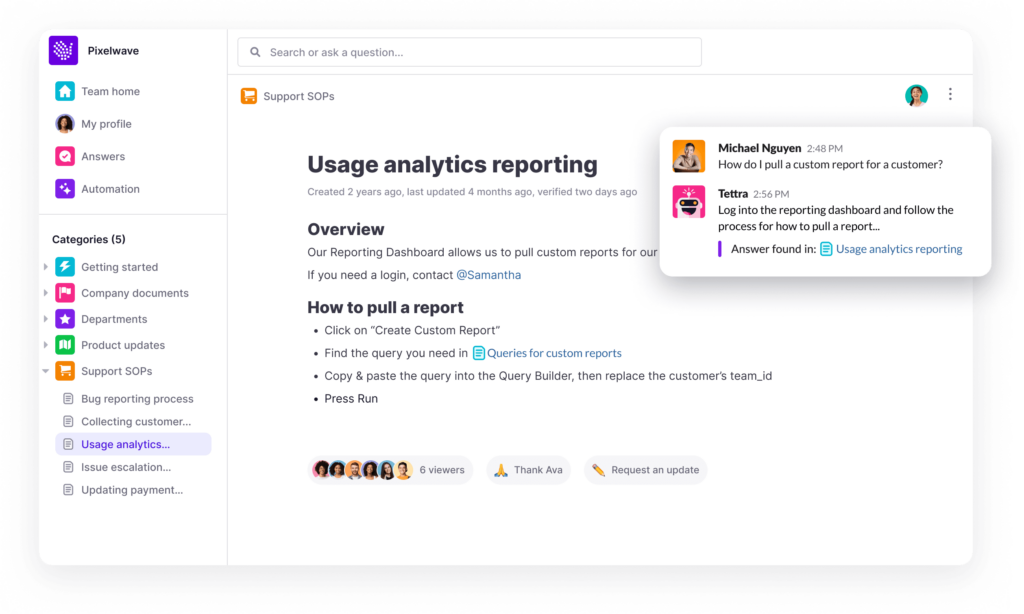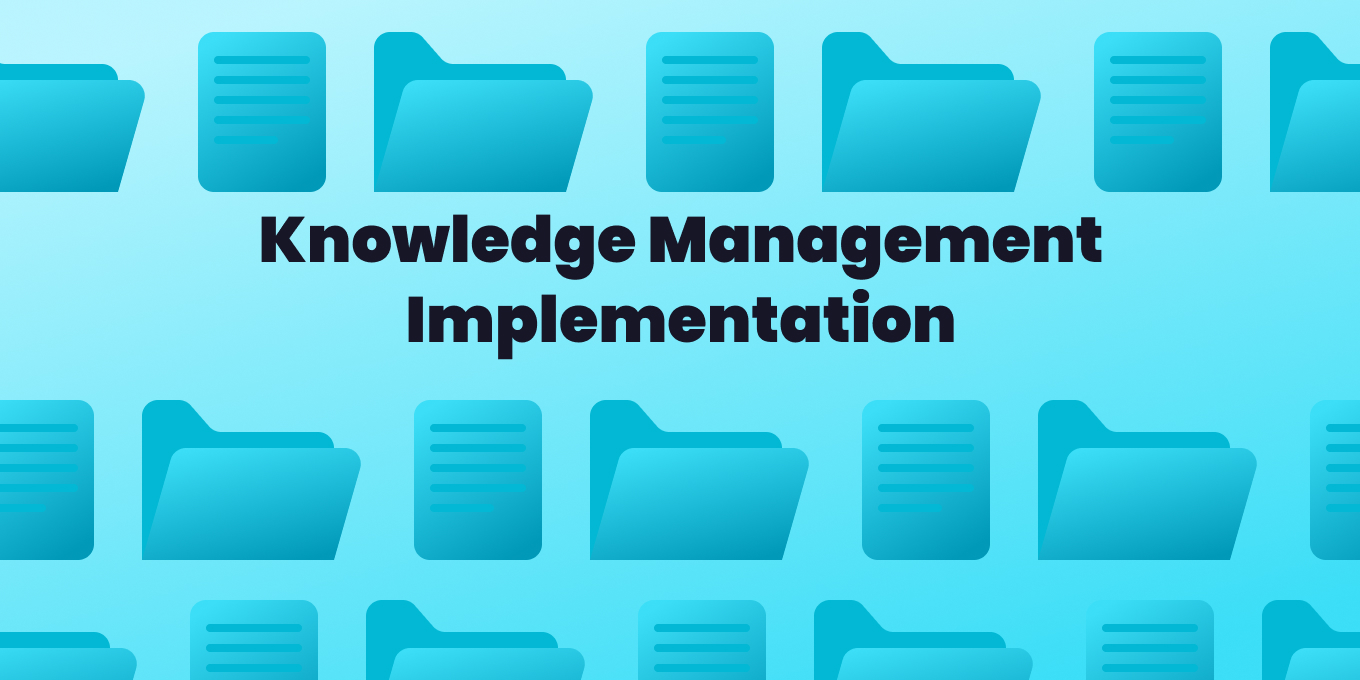As the organization grows and intellectual capital builds up over time, it becomes necessary to have a knowledge management system in place to keep track of all the hard-earned knowledge that has been gained.
However, having a knowledge management process is only half the battle; the other half of the challenge is implementing it efficiently and effectively across the organization.
Here’s how to do that.
The Challenges to Knowledge Management Implementation
The first step is to be aware of the obstacles that commonly stand in the way of a unified knowledge management base.
Since organizations are made up of people, these challenges all involve pushback from members that are set in their ways, believe the current system is better, or are otherwise resistant to change.
These challenges include:
Opposition
This is the tendency to oppose a unified implementation, when people believe their own methods are better and thus disregard material in the knowledge base or actively work to have it modified in favor of their own.
Conflict
This is when individuals or groups cannot agree on the knowledge material, so that some form of compromise or arbitration may be necessary.
Holding Out
Some team members may be reluctant to fully contribute to the knowledge base. They may withhold practical information like routines and experiences they believe gives them an edge over others, instead of sharing with their colleagues.
- Read more about challenges with knowledge management and how to overcome them.
How do you implement knowledge management?
Once you recognize the roadblocks, you can structure the implementation process with these (opposition, conflict, and holding out) in mind.
Step 1: Establish concrete goals
We know that the end goal of knowledge management is to capture all useful resources so that they can be easily accessed to create better outcomes. To get there however, it’s useful to set several smaller objectives.
This will allow you:
✔ Track your progress per milestone
✔ Quantify and measure the success of the implementation in practical KPIs
✔ Make everyone aware of what needs to be done, and what else is remaining to get there.
Some tangible goals could be:
- Number of database accesses
- Quantity of search queries
- Manpower hours saved in training and development
- Percentage of employees who use the knowledge base
- Number of issues or incidents resolved by KM references
Step 2: Delegation
Knowledge management applies across the entire organization, but the implementation is best overseen by a single individual. For this reason, it’s useful to have a knowledge manager who will oversee the whole process from conceptualization to execution.
For smaller organizations without a formal knowledge manager role, the following can make good candidates for being the knowledge management OIC:
- Program and Development Managers – since they already know how to build processes and codify them into best practices.
- Trainers – embodies institutional knowledge by experience, and knows how to share them.
- Operations managers – excellent grasp of the bigger picture, and the myriad routines and culture that make up the organization.
- Sales and CX managers – they know how to talk to people and capture information that benefits the knowledge base.
Once there is a single person in charge of knowledge management implementation, they will need help cascading it through the ranks. For this reason, management, department heads, and team leaders will need to be briefed on the project, so they can carry out the project down to the individual level.
Step 3: Outline the project
The goals establish the what, and the key players establish the who. Now it’s time to outline the how, as in how the knowledge management will be carried out.
For this you will need a strategy, just like any other project management.
Beyond lofty goals of knowledge capture and the betterment of the organization, the KM strategy should outline:
- The incremental steps needed to capture knowledge
- The entire organizational body that will contribute to the knowledge base, down to individual roles
- Critical business processes, routines, procedures and methods that need to be recorded
- KPIs
- Delivery dates
Remember that people work better when faced with goal posts to be accomplished. This helps break down the mammoth task of KM, and it also serves to quantify the abstract nature of knowledge capturing into something that can be accomplished, tracked, and timed in the real world.
Step 4: Prepare the team
With the strategy in place, the next step is to get everyone informed and involved. But most importantly, onboard. Since institutional knowledge comes from the people that make up the institution, effective and thorough KM can only be accomplished if all members agree on the need for a knowledge base, sharing, and the definition of what constitutes that knowledge.
This step may be the most challenging, but focus on these areas to make it less daunting:
- Use change management techniques to get them onboard the idea.
- List down solid benefits of KM that everyone can relate to, such as: more efficient everyday tasks, smoother cooperation between different working groups, less time wasted and less frustration, shorter learning time when faced with new tasks, situations, or procedures.
- Highlight the fact that everyone involved is critical: their knowledge is beneficial to the organization, it should be preserved for posterity and future learning, and they are helping to build entire methods, processes, and even a company culture.
- Resolve conflicting knowledge so that everyone can agree on what goes into the repository.
Step 5: Get trained on your new knowledge management system
With the buy-in secured, everyone involved will then have to learn the knowledge management system. They will need to be trained to use the tool or software to access specific knowledge areas, share, collaborate, or modify it as needed.
They can also upload or create the knowledge themselves, which can greatly hasten the process so that team leaders can be the editors, and the knowledge manager can focus on the macro picture.
If you choose Tettra as your knowledge management system, these straightforward videos and complete help site will show you the best practices.
6. Adopt and Optimize
Knowledge management doesn’t stop at the project execution. As knowledge constantly evolves, the knowledge base must be periodically updated. Without a plan in place for recurring validation and updates, a knowledge base can quickly become out of date.
Given time, the knowledge management system itself may need to be changed over to a new tool or software as technology moves on.
Why Tettra is the Top Choice for Knowledge Management Software
Rolling out a new knowledge management software?
Consider Tettra as your number one choice.
Tettra is a knowledge management, wiki and internal knowledge base in one. Customers love it because of its streamlined, beginner-friendly interface.

The question and answers feature allows anyone to ask a question, and then your subject matter expert can verify the correct responses.
This is more reliable than generic, all-purpose tools like Google Drive or Notion which leads to a lot of confusion about the current state of an answer or document.
“Very quickly after launching, the number of redundant questions decreased. Managers direct people to look in Tettra first, since the answer is usually there.”
GrandPad
It includes an intuitive UI and Slack integration, allowing users to utilize the knowledge base without leaving the popular messaging app.
With Tettra, you’ll get:
- AI-powered instant answers, from your knowledge base
- Q&A workflow to capture questions
- Knowledge base to document answers
- Knowledge management features to keep content up to date.
- Integrations with chat tools to make sure your team actually uses Tettra
Next:
Learn all about the Knowledge Management Strategy needed for a successful execution.


